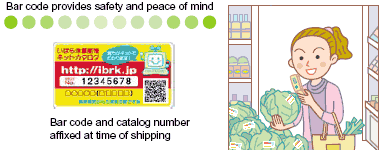Japanese Use Cell Phone QR Bar Code Readers to Check Food Safety

Belly up to the Bar Code: QR codes are reducing the fear factor for foodstuffs in Japan as agricultural associations embrace the new wireless technology tagging fresh produce for quick access to mobile information Web sites. A new English-language report [.PDF] released this month by NTT DoCoMo on QR code use in agriculture reveals the growing popularity of this medium.
Forget any assumptions about Hicksville. Japanese farmers have little fear of technology. Rural Ibaraki Prefecture has turbo charged their QR coding for agricultural products tagging a wide variety of vegetables grown in that prefecture. Ibaraki Prefectural authorities and the JA Ibaraki Prefecture Central Union of Agricultural Cooperative cooperating with other farming and agricultural associations are adding QR code labels right at the point of origin. In the supermarket, consumers use camera equipped cell phones to scan the QR code on the label. The code links to a mobile website detailing origin, soil composition, organic fertilizer content percentage (as opposed to chemical), use of pesticides and herbicides and even the name of the farm it was grown on. Consumers can also access the same information over the Ibaraki Agricultural Produce Net website by inputting a numbered code on each label.
A recent research report by the Ministry of Agriculture Forestry and Fisheries for 2004 showed nearly 90 percent of Japanese polled wanted to know where their fresh vegetables were grown. Use of agriculture chemicals and date of harvesting were also high priority concerns with consumers here and supermarkets have responded by increasing the amount of info on labels and in-store displays. Only so much information can be squeezed onto one peel-and-stick label but QR codes linked to a mobile website can pack thousands of characters into one symbol.
Open source QR codes by Denso Wave are the most common source for these information widgets in Japan. A survey by Market Researcher Infoplant of nearly 10,000 i-mode users in February of this year revealed 53.8 percent had used their phones to access QR code sites (.PDF in Japanese only) and a separate Infoplant survey tagged a 90 percent recognition of the QR code symbol.
New QR codes can be programmed with self-correcting error capabilities so that even if the code is dirty or slightly damaged –- a common side effect of supermarket labeling — it can still be scanned.
The innovative system has been welcomed by consumers and should lead to adoption by other prefectural agricultural cooperatives. Some consumer activists would like to see a similar system on beef packaging. BSE Mad Cow Disease scares have had serious impact on beef consumption by Japanese and US beef is still banned for sale in Japan.
— Gail Nakada

